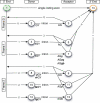Improving the Caenorhabditis elegans genome annotation using machine learning
- PMID: 17319737
- PMCID: PMC1808025
- DOI: 10.1371/journal.pcbi.0030020
Improving the Caenorhabditis elegans genome annotation using machine learning
Abstract
For modern biology, precise genome annotations are of prime importance, as they allow the accurate definition of genic regions. We employ state-of-the-art machine learning methods to assay and improve the accuracy of the genome annotation of the nematode Caenorhabditis elegans. The proposed machine learning system is trained to recognize exons and introns on the unspliced mRNA, utilizing recent advances in support vector machines and label sequence learning. In 87% (coding and untranslated regions) and 95% (coding regions only) of all genes tested in several out-of-sample evaluations, our method correctly identified all exons and introns. Notably, only 37% and 50%, respectively, of the presently unconfirmed genes in the C. elegans genome annotation agree with our predictions, thus we hypothesize that a sizable fraction of those genes are not correctly annotated. A retrospective evaluation of the Wormbase WS120 annotation [] of C. elegans reveals that splice form predictions on unconfirmed genes in WS120 are inaccurate in about 18% of the considered cases, while our predictions deviate from the truth only in 10%-13%. We experimentally analyzed 20 controversial genes on which our system and the annotation disagree, confirming the superiority of our predictions. While our method correctly predicted 75% of those cases, the standard annotation was never completely correct. The accuracy of our system is further corroborated by a comparison with two other recently proposed systems that can be used for splice form prediction: SNAP and ExonHunter. We conclude that the genome annotation of C. elegans and other organisms can be greatly enhanced using modern machine learning technology.
Conflict of interest statement
Figures






References
-
- The Caenorhabditis elegans sequencing consortium. Genome sequence of the Nematode Caenorhabditis elegans. A platform for investigating biology. Science. 1998;282:2012–2018. - PubMed
-
- Vapnik V. The nature of statistical learning theory. New York: Springer Verlag; 1995.
-
- Schölkopf B, Smola AJ. Learning with kernels. Cambridge (Massachusetts): MIT Press; 2002.
Publication types
MeSH terms
LinkOut - more resources
Full Text Sources

